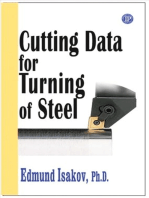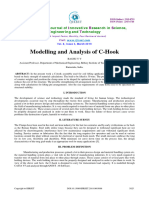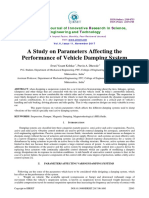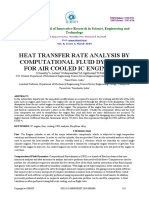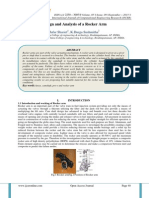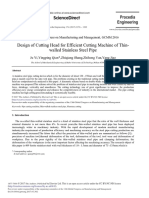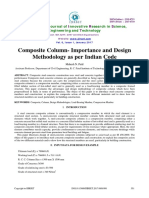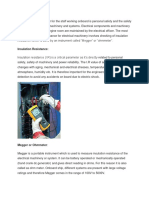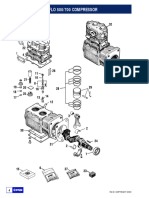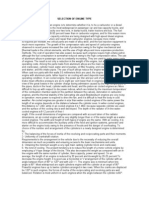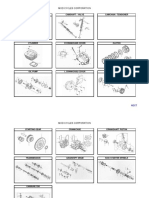Design and Fatigue Analysis of Crankshaft: Nternational Ournal of Nnovative Esearch in Cience, Ngineering and Echnology
Design and Fatigue Analysis of Crankshaft: Nternational Ournal of Nnovative Esearch in Cience, Ngineering and Echnology
Uploaded by
Ashutosh VermaCopyright:
Available Formats
Design and Fatigue Analysis of Crankshaft: Nternational Ournal of Nnovative Esearch in Cience, Ngineering and Echnology
Design and Fatigue Analysis of Crankshaft: Nternational Ournal of Nnovative Esearch in Cience, Ngineering and Echnology
Uploaded by
Ashutosh VermaOriginal Title
Copyright
Available Formats
Share this document
Did you find this document useful?
Is this content inappropriate?
Copyright:
Available Formats
Design and Fatigue Analysis of Crankshaft: Nternational Ournal of Nnovative Esearch in Cience, Ngineering and Echnology
Design and Fatigue Analysis of Crankshaft: Nternational Ournal of Nnovative Esearch in Cience, Ngineering and Echnology
Uploaded by
Ashutosh VermaCopyright:
Available Formats
ISSN(Online): 2319-8753
ISSN (Print) : 2347-6710
International Journal of Innovative Research in Science,
Engineering and Technology
(A High Impact Factor, Monthly, Peer Reviewed Journal)
Visit: www.ijirset.com
Vol. 7, Issue 2, February 2018
Design and Fatigue Analysis of Crankshaft
R.Raju 1, K.Namcharaiah2
P.G. Student, Department of Mechanical Engineering, VNR College of Engineering, Ponnur, Guntur, India1
Associate Professor, Department of Mechanical Engineering, VNR College of Engineering, Ponnur, Guntur, India2
ABSTRACT: A crankshaft is a fundamental feature in a vehicle's engine. It is the prime mover which is responsible
for the conversion of linear energy into rotational energy. The crankshaft changes the piston motion with the help of
connecting rods which inturn enable the engine to run. Hence, crankshaft is the most critical part of any assembly and
its life can be improved if maintained properly. This paper deals with the material composition and the manufacturing
processes usually followed for crankshafts and also the possible causes of failure and their analysis. In this regard, a
model of the crankshaft has been prepared using NX CAD 8.5 version and with the help of an analysis workbench,
ANSYS (the premier CAE tool since forty years), we were able to analyze the stress distribution and deformation for
two different materials. Finally, on the basis of the results acquired, suggestions with regard to the improvement in
design have been made.
KEYWORDS: Crankshaft, Modelling, Analysis, NX CAD, ANSYS, Suggestions, Failure
I. INTRODUCTION
Crank shaft is a large component with a complex geometry in the engine, which converts the reciprocating
displacement of the piston to a rotary motion with a four link mechanism. Since the crank shaft experiences a large
number of load cycles during its service life, fatigue performance and durability of this component has to be considered
in the design process. Design developments have always been an important issue in the crankshaft production industry,
in order to manufacture a less expensive component with the minimum weight possible and proper fatigue strength and
other functional requirements. These improvements result in lighter and smaller engines with better fuel efficiency and
higher power output. This study was conducted on a four cylinder four stroke cycle engine.
Copyright to IJIRSET DOI:10.15680/IJIRSET.2018.0702040 1868
ISSN(Online): 2319-8753
ISSN (Print) : 2347-6710
International Journal of Innovative Research in Science,
Engineering and Technology
(A High Impact Factor, Monthly, Peer Reviewed Journal)
Visit: www.ijirset.com
Vol. 7, Issue 2, February 2018
Figure 1.1 presents a typical crankshaft with journals which actually act as supporters for the crankshaft. The crank
shaft, connecting rod, and piston constitute a four bar slider-crank mechanism, which converts the sliding motion of the
piston (slider in the mechanism) to a rotary motion. Since the rotation output is more practical and applicable for input
to other devices, the concept design of an engine is that the output would be rotation. In addition, the linear
displacement of an engine is not smooth, as the displacement is caused by the combustion of gas in the combustion
chamber. Therefore, the displacement has sudden shocks and using this input for another device may cause damage to
it. The concept of using crankshaft is to change these sudden displacements to a smooth rotary output, which is the
input to many devices such as generators, pumps, and compressors.
Paper is organized as follows. Section II describes related information about crankshaft, section III lists out various
materials and manufacturing processes for crankshafts especially single cylinder ones whereas section IV presents the
experimental results and section V presents conclusion.
II. RELATED INFORMATION
Crank shaft experiences large forces from gas combustion. This force is applied to top of the piston and since the
connecting rod connects the piston to the crank shaft, this force will be transmitted to the crank shaft. The magnitude of
the force depends on many factors which consist of crank radius, connecting rod dimensions, and weight of the
connecting rod, piston, piston rings, and pin. Combustion and inertia forces acting on the crankshaft cause two types of
loading on the crankshaft structure; torsional load and bending load. There are many sources of failure in the engine.
They could be categorized as operating sources, mechanical sources, and repairing sources. One of the most common
crankshaft failures is fatigue at the fillet areas due to bending load caused by the combustion. Even with a soft case as
journal bearing contact surface, in a crankshaft free of internal flaws one would still expect a bending or torsional
fatigue crack to initiate at the pin surface, radius, or at the surface of an oil hole.
This study was motivated by a need for a comparative study of analysis of crankshaft made of aluminum and its
alloys which are some of the mostly used materials to manufacture the crankshafts. It was desired to develop an
optimized geometry, material, and manufacturing procedure, which will reduce the weight for fuel efficiency. This
research was performed on crankshafts from single cylinder engines. However, since the basis of analysis are the same
for multi-cylinder engines, the procedures used could be modified and implemented for crankshafts from other types of
engines. Other studies on crankshafts from multi-cylinder engines are typically performed on a portion of the
crankshaft consisting of two journal bearings and one crankpin bearing, which is similar to that of a single cylinder
engine.
III. MATERIALS AND MANUFACTURING PROCESSES
The major crankshaft material competitors currently used in industry are forged steel, cast iron and aluminum.
Comparison of the performance of these materials with respect to static, cyclic, and impact loading are of great interest
to the automotive industry. A comprehensive comparison of manufacturing processes with respect to mechanical
properties, manufacturing aspects, and finished cost for crankshafts has been conducted by Zoroufi and Fatemi. This
section discusses forging and casting processes as the two competing manufacturing processes in crankshaft production
industry. Influencing parameters in both processes are detailed. Finally, the forged steel and the cast iron products are
compared in terms of material properties and manufacturing processes.
Forging is the term for shaping metal by plastic deformation. Cold forging is done at low temperatures, while
conventional hot forging is done at high temperatures, which makes metal easier to shape. Cold forgings are various
forging processes conducted at near ambient temperatures, such as bending, cold drawing, cold heading, coining, and
extrusion to produce metal components to close tolerances and net shape . Warm forging is a modification of the cold
forging process where the workpiece is heated to a temperature significantly below the typical hot forging temperature,
ranging from 500º C to 750º C Compared with cold forging, warm forging has the potential advantages of reduced
Copyright to IJIRSET DOI:10.15680/IJIRSET.2018.0702040 1869
ISSN(Online): 2319-8753
ISSN (Print) : 2347-6710
International Journal of Innovative Research in Science,
Engineering and Technology
(A High Impact Factor, Monthly, Peer Reviewed Journal)
Visit: www.ijirset.com
Vol. 7, Issue 2, February 2018
tooling loads, reduced press loads, increased steel ductility, elimination of need to anneal prior to forging, and
favorable as-forged properties that can eliminate heat treatment . The use of the lower temperatures in cold and warm
forging processes provides the advantages of reducing and even substantially eliminating
IV. EXPERIMENTAL RESULTS
Fig 2: NX CAD model of crankshaft
Fig 3 Steel Material Fig 4 Steel Material
Static structural analysis has been conducted on the crankshaft by applying two different materials, Steel and Grey cast
iron. Based on the stress distribution and maximum deformation results, we get to know which material suits better for
the crankshaft and thus, fatigue life can be calculated.
Copyright to IJIRSET DOI:10.15680/IJIRSET.2018.0702040 1870
ISSN(Online): 2319-8753
ISSN (Print) : 2347-6710
International Journal of Innovative Research in Science,
Engineering and Technology
(A High Impact Factor, Monthly, Peer Reviewed Journal)
Visit: www.ijirset.com
Vol. 7, Issue 2, February 2018
Fig 5 Grey Cast Iron Fig 6 Grey Cast Iron
Figure 2 presents the CAD model of the crankshaft designed using NX CAD software and the corresponding figures
Fig. 3, Fig. 4, Fig. 5 & Fig. 6 explain the results attained on successful completion of the static structural analysis.
Hence, on the basis of the results obtained, conclusion has been derived.
V. CONCLUSION
In our project from the above analysis, we observe that there has been considerable increase in the von mises stress
(max.) for Grey Cast Iron. We can also derive that the maximum deformation value is 5.572e-3mm for Grey Cast Iron
as compared to 5.821e-3mm with Steel. Hence, fatigue life will be more for Grey Cast Iron than that of Steel.
REFERENCES
[1] Rincle Garg,Sunil Baghla,“Finite element analysis and optimization of crankshaft”,International Journal of Engineering and Management
Reaserch,vol-2, Issue-6, ISSN:2250-0758, Pages:26-31, December 2012.
[2] C.M Balamurugan, R.Krishnaraj, Dr.M.sakhivel, K.kanthavel, DeepanMarudachalam M.G,R.Palani, “Computer aided modeling and analysis
of crankshaft”, International Journal of scientific and Engineering Research, Vol-2, issue-8, ISSN: 2229-5518, August-2011
[3] Gu Yingkui, ZhouZhibo, “Strength Analysis of Diesel Engine Crankshaft Based on PRO/E and ANSYS”, Third International Conference on
Measuring Technology and Mechatronics Automation, 2011
[4] Abhishek Choubey, Jamin Brambhatt, “Design and Analysis of Crankshaft For Single Cylinder 4-stroke engine”, International Journal of
Advanced Engineering Research and Studies, Vol-1, issue-4, ISSN: 2249-8974, pages: 88-90, July-Sept. 2012
[5] R.J. Deshbharatar, Y.R Suple, “Analysis and Optimization of Crankshaft using FEM”, International Journal of Modern Engineering Research,
Vol-2,issue-5, ISSN:2249-6645,pages: 3086-3088, Sept-Oct-2012
[6] Farzin H. Montazeradghand Ali Fatemi, “Stress Analysis and Optimization of Crankshaft subjected to Dynamic Loading”, AISI, August 2007
[7] F.S. Silva, “Analysis of a vehicle crankshaft failure”, Engineering failure analysis 10 (2003) 605-616
[8] Jaimin Brambhatt1, Prof. Abhishek Choubey2, “Design and analysis of crankshaft for single cylinder 4-stroke diesel engine,” International
Journal of Advanced Engineering Research and Studies, E-ISSN 2249-8974
[9] Jian Meng,Yongqui Liu, Ruixiang Liu, “Finite Element Analysis of 4-Cylinder Diesel Crankshaft,” MECS, I.J. Image, Graphics and Signal
Processing, 2011,5,22-29
[10] G.H. Farrahi, F. Hemmati, S.M.H-Gangaraj, S.Abolhassani, M. Sakhaei,”Failure Analysis of a Four Cylinder Diesel Engine Crankshaft
Made From Nodular Cast Iron,” The Journal of Engine Research/Vol.22/Spring 2011
[11] Amit Solankil, Ketan Tamboli2,M.J.Zinjuwadia3, “Crankshaft Design and Optimization-A Review,” National Conference on Recent Trends
in Engineering & Technology, 2011
[12] Momin Muhammad Zia Muhammad Idris, “Crankshaft Strength Analysis Using Finite Element Method.” International Journal of
Engineering Research and Applications (IJERA) ISSN: 2248-9622, Vol. 3, Issue 1, January-February 2013, pp 1694-1698
Copyright to IJIRSET DOI:10.15680/IJIRSET.2018.0702040 1871
You might also like
- Spare Parts Catalogue - D2876 LE301 - EngDocument138 pagesSpare Parts Catalogue - D2876 LE301 - EngGeorge Domusciu90% (10)
- Massey Ferguson MF 1134 Tractor Service Parts Catalogue ManualDocument14 pagesMassey Ferguson MF 1134 Tractor Service Parts Catalogue Manualqlb89831650% (2)
- 4-Cylinder Diesel Engine (AXB AXC BRR BRS)Document171 pages4-Cylinder Diesel Engine (AXB AXC BRR BRS)Yoga Aditya100% (1)
- Machine Tool Spindle UnitsDocument22 pagesMachine Tool Spindle UnitsMaricel Cearmel100% (2)
- Ultrasonic Welding of Lithium-Ion Batteries: Enter asset subtitleFrom EverandUltrasonic Welding of Lithium-Ion Batteries: Enter asset subtitleNo ratings yet
- Caterpillar Service Manual CT S Eng3304dDocument10 pagesCaterpillar Service Manual CT S Eng3304dHugo VillcaNo ratings yet
- Detroit Diesel Miami SERIES 60 Parts CatalogDocument16 pagesDetroit Diesel Miami SERIES 60 Parts CatalogÖnder Büyükişcan100% (3)
- Design, Analysis and Testing of Spindle For High Speed CNC Lathe MachineDocument8 pagesDesign, Analysis and Testing of Spindle For High Speed CNC Lathe MachineArif NurrohmanNo ratings yet
- Design and Structural Analysis of Ceramic Coated Petrol Engine Piston Using Finite Element MethodDocument11 pagesDesign and Structural Analysis of Ceramic Coated Petrol Engine Piston Using Finite Element Methodravi kumar B v ANo ratings yet
- 66 3 ModellingDocument9 pages66 3 ModellingReza JavadianNo ratings yet
- 43 Rtmeas67Document20 pages43 Rtmeas67c.farhan.fNo ratings yet
- 30 Effect NEWDocument8 pages30 Effect NEWBhavesh RanaNo ratings yet
- Design and Assembly Analysis of Piston, Connecting Rod & CrankshaftDocument12 pagesDesign and Assembly Analysis of Piston, Connecting Rod & CrankshaftD Masthan100% (1)
- WT ReportDocument18 pagesWT ReportmariaantonyvargheesmichaeljoelNo ratings yet
- 87 DesignDocument4 pages87 Designmadhanreddy953No ratings yet
- Structural Analysis of Gas Turbine Blade by Using ANSYS 1Document5 pagesStructural Analysis of Gas Turbine Blade by Using ANSYS 1Nitin SinghNo ratings yet
- Design and Topology Optimization of Two-Stage Gearbox For All-Terrain VehiclesDocument9 pagesDesign and Topology Optimization of Two-Stage Gearbox For All-Terrain VehiclesAndy YanNo ratings yet
- Design Structural and Thermal Analysis oDocument10 pagesDesign Structural and Thermal Analysis oseid negashNo ratings yet
- Early3 Include Blade ThicknessDocument10 pagesEarly3 Include Blade ThicknessarjunNo ratings yet
- Ijett V38P253 PDFDocument7 pagesIjett V38P253 PDFKaustubh DwivediNo ratings yet
- Design & Optimization Gudgeon Pin For C.I. EngineDocument12 pagesDesign & Optimization Gudgeon Pin For C.I. EngineIJRASETPublicationsNo ratings yet
- Design and Analysis of Frame For Electric MotorcycleDocument8 pagesDesign and Analysis of Frame For Electric MotorcycleChu Ngọc TúNo ratings yet
- 68 - Design - Analysis - Fabrication of Maglev Vertical Axis Wind Turbine-VAMWTDocument12 pages68 - Design - Analysis - Fabrication of Maglev Vertical Axis Wind Turbine-VAMWTriya vermaNo ratings yet
- International Journal of Computational Engineering Research (IJCER)Document5 pagesInternational Journal of Computational Engineering Research (IJCER)International Journal of computational Engineering research (IJCER)No ratings yet
- Design and Analysis of Propeller Shaft: Nternational Ournal of Nnovative Esearch in Cience, Ngineering and EchnologyDocument9 pagesDesign and Analysis of Propeller Shaft: Nternational Ournal of Nnovative Esearch in Cience, Ngineering and EchnologyRaja ManeNo ratings yet
- Al7075 AnsysDocument7 pagesAl7075 AnsysBlack MNo ratings yet
- Modeling and Analysis of Steam Turbine Blade-Ijaerdv05i0451562n PDFDocument11 pagesModeling and Analysis of Steam Turbine Blade-Ijaerdv05i0451562n PDFGuruvenu KamanuruNo ratings yet
- Design and Fabrication of Pneumatic Sheet Metal Cutting and Pneumatic Sheet Metal Bending MachineDocument6 pagesDesign and Fabrication of Pneumatic Sheet Metal Cutting and Pneumatic Sheet Metal Bending MachineAnonymous kw8Yrp0R5rNo ratings yet
- Lázaro Plata 2020 J. Phys. Conf. Ser. 1587 012034Document8 pagesLázaro Plata 2020 J. Phys. Conf. Ser. 1587 012034fernandoNo ratings yet
- Design and Analysis of Chain Sprocket Using ReversDocument9 pagesDesign and Analysis of Chain Sprocket Using ReversAhmed MohamedNo ratings yet
- R.Aparna Shetty 1Document13 pagesR.Aparna Shetty 1Samiullah MohammedNo ratings yet
- Ijireeice 2022 10509Document5 pagesIjireeice 2022 10509Prajwal TilekarNo ratings yet
- Blisk TechnologyDocument25 pagesBlisk TechnologyMichele AndreozziNo ratings yet
- Design Analysis & Optimization of Hub Used in FSAE CarsDocument10 pagesDesign Analysis & Optimization of Hub Used in FSAE CarsMukul ChandraNo ratings yet
- Finite Element Analysis of Ball Bearing For Different MaterialsDocument5 pagesFinite Element Analysis of Ball Bearing For Different MaterialsEditor IJTSRDNo ratings yet
- 223 SalaisivabalanDocument8 pages223 SalaisivabalanMatthew SmithNo ratings yet
- 13 013 Design PDFDocument6 pages13 013 Design PDFMayur RaundalNo ratings yet
- 43 - 6 - Final Manuscript Ij61111623Document3 pages43 - 6 - Final Manuscript Ij61111623skNo ratings yet
- Structural Design and Analysis of Gas Turbine Blade Using Cae Tools IJERTV3IS100482Document6 pagesStructural Design and Analysis of Gas Turbine Blade Using Cae Tools IJERTV3IS100482Sai SushmaNo ratings yet
- Finite Element Analysis of Connecting Rod For Two Wheeler and Optimization of Suitable Material Under Static Load ConditionDocument7 pagesFinite Element Analysis of Connecting Rod For Two Wheeler and Optimization of Suitable Material Under Static Load ConditionAnonymous CUPykm6DZNo ratings yet
- Heat Transfer Rate Analysis by Computational Fluid Dynamics For Air Cooled Ic Engine FinsDocument7 pagesHeat Transfer Rate Analysis by Computational Fluid Dynamics For Air Cooled Ic Engine FinsHaran PrabhaNo ratings yet
- Thermal Stress Analysis and Optimization of FSW Process On UHMWPE by Using Hexagonal Tool ProfileDocument10 pagesThermal Stress Analysis and Optimization of FSW Process On UHMWPE by Using Hexagonal Tool ProfileIJRASETPublicationsNo ratings yet
- Analyzing The Car Disc Brake Using A Combination of Modelling and Static Structural TechniquesDocument7 pagesAnalyzing The Car Disc Brake Using A Combination of Modelling and Static Structural TechniquesInternational Journal of Innovative Science and Research TechnologyNo ratings yet
- SR211116185549Document4 pagesSR211116185549putyandhini3No ratings yet
- Analysis and Optimization of Cutting ParDocument7 pagesAnalysis and Optimization of Cutting Parpintakaning rungssitNo ratings yet
- Structural Analysis and Optimization of Aircraft Rudder: June 2018Document10 pagesStructural Analysis and Optimization of Aircraft Rudder: June 2018Indah KhairunnisaNo ratings yet
- Thermal Fatigue Analysis of Exhaust ManifoldDocument11 pagesThermal Fatigue Analysis of Exhaust ManifoldIJRASETPublicationsNo ratings yet
- Vortex Wind Analysis of Vertical Tall Process Column019896Document7 pagesVortex Wind Analysis of Vertical Tall Process Column019896jhunkujha11No ratings yet
- Disk Brake Designing For Go-Kart: Nternational Ournal of Nnovative Esearch in Cience, Ngineering and EchnologyDocument8 pagesDisk Brake Designing For Go-Kart: Nternational Ournal of Nnovative Esearch in Cience, Ngineering and EchnologyDurgeshNo ratings yet
- Milestone No. 01 - CAE LABDocument9 pagesMilestone No. 01 - CAE LABMuhammad Junaid Rajput FatimaNo ratings yet
- Nasa Rolling-Element Bearings - A Review of State of ArtDocument87 pagesNasa Rolling-Element Bearings - A Review of State of Artchetan_thakur4278100% (2)
- Design and Analysis of Alloy Wheel Rim: I J I R S E TDocument6 pagesDesign and Analysis of Alloy Wheel Rim: I J I R S E Tkiran_sridharaNo ratings yet
- Design and Fabrication of Pneumatic Sheet Metal Cutting and Bending MachineDocument9 pagesDesign and Fabrication of Pneumatic Sheet Metal Cutting and Bending MachineKanaga VaratharajanNo ratings yet
- 187 MR160703 Shrikant Paper V1Document11 pages187 MR160703 Shrikant Paper V1khai6367No ratings yet
- Design and Analysis of A Rocker ArmDocument5 pagesDesign and Analysis of A Rocker ArmInternational Journal of computational Engineering research (IJCER)No ratings yet
- Design and Analysis of Dual Side Shaper Using Scotch Yoke MechanismDocument8 pagesDesign and Analysis of Dual Side Shaper Using Scotch Yoke MechanismDavid CristhianNo ratings yet
- Structural Analysis of Work Roll Chock and Backup Roll Chock in Cold Rolling MillDocument11 pagesStructural Analysis of Work Roll Chock and Backup Roll Chock in Cold Rolling MillFirozPathanNo ratings yet
- Power Generating Shock Absorber: I J I R S E TDocument12 pagesPower Generating Shock Absorber: I J I R S E TKiran PatilNo ratings yet
- Design of Cutting Head For Efficient Cutting MachiDocument7 pagesDesign of Cutting Head For Efficient Cutting MachiJackson MtongaNo ratings yet
- Design and Fabrication of Gravity Power GenerationDocument5 pagesDesign and Fabrication of Gravity Power GenerationGhafar HassanNo ratings yet
- 191 52 MadhuDocument11 pages191 52 MadhuDekeba GetemaNo ratings yet
- Tensile Test & FEM Analysis of ABS Material Using FDM TechniqueDocument6 pagesTensile Test & FEM Analysis of ABS Material Using FDM TechniquemohamadNo ratings yet
- Composite Column-Importance and Design Methodology As Per Indian CodeDocument5 pagesComposite Column-Importance and Design Methodology As Per Indian CodeLucas HoodNo ratings yet
- Experimental and Numerical Analysis of Crankshaft Used in Hero Honda Splendor MotorcycleDocument12 pagesExperimental and Numerical Analysis of Crankshaft Used in Hero Honda Splendor MotorcycleAshutosh VermaNo ratings yet
- Ijser: Evaluation of Fatigue Life of The CrankshaftDocument5 pagesIjser: Evaluation of Fatigue Life of The CrankshaftAshutosh VermaNo ratings yet
- Engineering Failure Analysis: Wei Li, Qing Yan, Jianhua XueDocument9 pagesEngineering Failure Analysis: Wei Li, Qing Yan, Jianhua XueAshutosh VermaNo ratings yet
- Reference PDFDocument5 pagesReference PDFAshutosh VermaNo ratings yet
- Snipper Reference 2Document12 pagesSnipper Reference 2Ashutosh VermaNo ratings yet
- Chebyshev Orthogonal Collocation Technique To Solve Transport Phenomena Problems With Matlab and MathematicaDocument10 pagesChebyshev Orthogonal Collocation Technique To Solve Transport Phenomena Problems With Matlab and MathematicaAshutosh VermaNo ratings yet
- Part A: Linear AerodynamicsDocument22 pagesPart A: Linear AerodynamicsAshutosh VermaNo ratings yet
- Reference3 Slipener ADocument2 pagesReference3 Slipener AAshutosh VermaNo ratings yet
- Advance Heat Transfer - 2Document2 pagesAdvance Heat Transfer - 2Himansu BisoiNo ratings yet
- Reference Main Above 1Document16 pagesReference Main Above 1Ashutosh VermaNo ratings yet
- EGR9022M Applied Finite Element Analysis Coursework 2 Module Assessment Briefing Template 2019-2020Document4 pagesEGR9022M Applied Finite Element Analysis Coursework 2 Module Assessment Briefing Template 2019-2020Ashutosh VermaNo ratings yet
- Ijreas Volume 2, Issue 2 (February 2012) ISSN: 2249-3905 Numerical Simulation of Two Stage Cascade Refrigeration System Using Refrigerant R 12 - R170, R 502 - R 1150 AND R 717-R 1270Document8 pagesIjreas Volume 2, Issue 2 (February 2012) ISSN: 2249-3905 Numerical Simulation of Two Stage Cascade Refrigeration System Using Refrigerant R 12 - R170, R 502 - R 1150 AND R 717-R 1270Ashutosh VermaNo ratings yet
- Elect NotesDocument101 pagesElect NotesMeyyappan SankarNo ratings yet
- Service Manual: EH09, EH12-2 Rammer EnginesDocument84 pagesService Manual: EH09, EH12-2 Rammer Enginesmihai37100% (1)
- Parts Catalog: Serial NumberDocument68 pagesParts Catalog: Serial NumberMarce LaraNo ratings yet
- Travel, Speed and Acceleration of PistonDocument6 pagesTravel, Speed and Acceleration of PistonSertronic SolutionNo ratings yet
- Report PDFDocument58 pagesReport PDFBlahNo ratings yet
- BENDIX TF 500 700 PartesDocument9 pagesBENDIX TF 500 700 PartesJime CastroNo ratings yet
- Kawasaki: Mower Service Manual KawasakiDocument6 pagesKawasaki: Mower Service Manual KawasakiProducciones3NNo ratings yet
- Integral Acc DriveDocument133 pagesIntegral Acc DriveJoseSantiagoMontañoBucio100% (1)
- Manual Taller Motor SISU 84 - ASP - 3B - WSM - EngDocument113 pagesManual Taller Motor SISU 84 - ASP - 3B - WSM - EngXavier Solias RibaltaNo ratings yet
- Selection of Engine TypeDocument3 pagesSelection of Engine TypeSanthosh RamananNo ratings yet
- Em Yd1Document98 pagesEm Yd1AnthonyNo ratings yet
- TWJ 5000 Litres - New FormaDocument3 pagesTWJ 5000 Litres - New Formamuhammad iqbalNo ratings yet
- Massey Ferguson MF 396 C CRAWLER (IT) Parts Catalogue Manual Instant DownloadDocument27 pagesMassey Ferguson MF 396 C CRAWLER (IT) Parts Catalogue Manual Instant Downloadgabeaden26No ratings yet
- EngineDocument41 pagesEngineGurmeet Mehma100% (5)
- Yumbo Dakar 125Document71 pagesYumbo Dakar 125Wilder Esteban MendozaNo ratings yet
- Ic Engine Terminolgy PDFDocument20 pagesIc Engine Terminolgy PDFDinesh KumarNo ratings yet
- Engine 4G9 SeriesDocument171 pagesEngine 4G9 Seriesmanuel carrilloNo ratings yet
- Mantenimiento Compresor BlackmerDocument10 pagesMantenimiento Compresor BlackmerMarco NoccettiNo ratings yet
- 2002 HD VRSCA Service & Electrical Diagnostics 99501-02A & 99499-02Document746 pages2002 HD VRSCA Service & Electrical Diagnostics 99501-02A & 99499-02Đan 12A3 NgọcNo ratings yet
- Dynamics of MachineryDocument15 pagesDynamics of MachinerySabareeswaran MurugesanNo ratings yet
- Yuchai YC4A115Z T20Document74 pagesYuchai YC4A115Z T20João Roberto Guedes PrazeresNo ratings yet
- MTZ-2008-04 - The New Boxer Engine of The BMW HP2 SportDocument8 pagesMTZ-2008-04 - The New Boxer Engine of The BMW HP2 SportBranko KatanaNo ratings yet
- Gudgeon PinDocument4 pagesGudgeon PinDipen KNo ratings yet
- W Series ManualDocument64 pagesW Series ManualNadia WilsonNo ratings yet
- WD10 Stage II Engine Manual of Weichai (EN) - V1-20190625 - 20201127144450167Document121 pagesWD10 Stage II Engine Manual of Weichai (EN) - V1-20190625 - 20201127144450167zein zeeNo ratings yet




